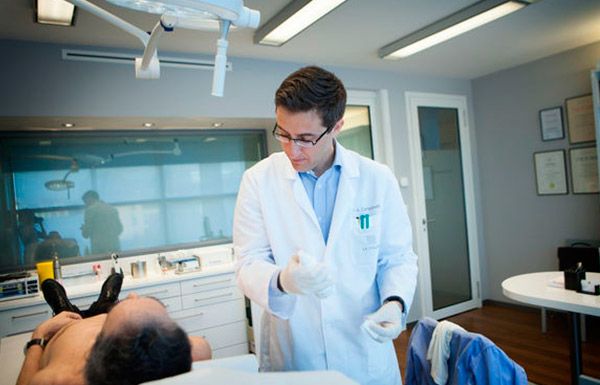Medical expert of the article
New publications
Peyronie's disease
Last reviewed: 04.07.2025

All iLive content is medically reviewed or fact checked to ensure as much factual accuracy as possible.
We have strict sourcing guidelines and only link to reputable media sites, academic research institutions and, whenever possible, medically peer reviewed studies. Note that the numbers in parentheses ([1], [2], etc.) are clickable links to these studies.
If you feel that any of our content is inaccurate, out-of-date, or otherwise questionable, please select it and press Ctrl + Enter.
Peyronie's disease (fibroplastic induration of the penis) is an idiopathic fibrosis of the tunica albuginea and/or areolar connective tissue between the tunica albuginea and the cavernous tissue of the penis. Peyronie's disease was first described in 1743 by Francois de la Peyronie.
 [ 1 ]
[ 1 ]
Epidemiology
Clinical symptoms of Peyronie's disease occur in 0.39-2% of cases, but this prevalence is only a statistical equivalent of the number of visits for this disease. The true prevalence of Peyronie's disease is much higher - 3-4% of cases in the general male population. 64% of men who suffer from Peyronie's disease are in the age group from 40 to 59 years, with a general occurrence in a fairly large age population - from 18 to 80 years. In men under 20 years of age, Peyronie's disease occurs in 0.6-1.5% of cases.
 [ 2 ], [ 3 ], [ 4 ], [ 5 ], [ 6 ], [ 7 ], [ 8 ], [ 9 ], [ 10 ], [ 11 ], [ 12 ]
[ 2 ], [ 3 ], [ 4 ], [ 5 ], [ 6 ], [ 7 ], [ 8 ], [ 9 ], [ 10 ], [ 11 ], [ 12 ]
Causes Peyronie's disease
The causes of Peyronie's disease remain unclear.
The most widespread theory is that Peyronie's disease occurs as a result of chronic trauma to the cavernous bodies of the penis during coitus. According to the post-traumatic theory, inflammatory mediators in the area of microtrauma of the protein membrane disrupt the reparative process, changing the ratio of elastic and collagen fibers in the penis. Peyronie's disease is often combined with Dupuytren's contracture and other local forms of fibromatosis, which allows us to characterize this disease as a local manifestation of systemic collagenosis.
There is also an autoimmune theory of the development of Peyronie's disease. According to this theory, Peyronie's disease begins with inflammation of the protein coat of the cavernous bodies of the penis, accompanied by lymphocytic and plasmacytic infiltration. The infiltrate, as a rule, does not have clear boundaries. Subsequently, a section of fibrosis and calcification is formed in this area. Since the elasticity of the protein coat in the plaque area is sharply limited during erection, varying degrees of curvature of the penis occur.
As a rule, the process of plaque formation and stabilization of the disease occurs 6-18 months after its onset.
Involvement of the Buck's fascia, perforating vessels and dorsal arteries of the penis leads to disruption of the venous occlusion mechanism and arterial insufficiency of the penis.
 [ 13 ]
[ 13 ]
Symptoms Peyronie's disease
Symptoms of Peyronie's disease include:
- erectile deformity of the penis;
- pain during erection;
- the formation of a palpable plaque or "bump" on the penis
There are different types of clinical course of Peyronie's disease.
Symptoms of Peyronie's disease may be absent and manifest only by the presence of "new growths" of the penis, which can be detected by palpation. In the clinical course of Peyronie's disease, severe pain and deformation of the penis during erection may be present. In some cases, especially with the circular nature of the lesion, there is a significant shortening of the penis, and sometimes Peyronie's disease is clinically manifested only by erectile dysfunction.

During the course of Peyronie's disease, there is an "acute" phase and a stabilization phase, which lasts from 6 to 12 months. Complications that develop during the natural course of Peyronie's disease include erectile dysfunction and shortening of the penis.
Diagnostics Peyronie's disease
Diagnosis of Peyronie's disease is usually straightforward and is based on the patient's medical history, complaints, and physical examination (palpation of the penis). Rarely, Peyronie's disease disguises itself as carcinoma of the penis, leukemic infiltration, lymphogranuloma, and lesions in late syphilis. More often, Peyronie's disease must be differentiated from lymphangitis and thrombosis of the superficial veins of the penis.
Examination of a patient with Peyronie's disease, along with general clinical methods, involves:
- assessment of the degree of erectile dysfunction (photography, injection tests or tests with phosphodiesterase type 5 inhibitors);
- assessment of the anthropometric characteristics of the penis in a relaxed state and in an erect state;
- study of penile hemodynamics (pharmacodopplerography, nocturnal penile tumescence).
It is advisable to conduct sexological testing.
Penile ultrasound is widely used in the diagnosis of Peyronie's disease. Unfortunately, detection of the plaque with detailed structure is possible only in 39% of cases, due to its polymorphism and multi-level nature of growth.

It is generally accepted that the size of the plaque and its dynamic changes from a clinical perspective and for the prognosis of the disease are not of decisive importance.
 [ 14 ], [ 15 ], [ 16 ], [ 17 ]
[ 14 ], [ 15 ], [ 16 ], [ 17 ]
Example of diagnosis formulation
- Peyronie's disease, stabilization phase, erectile deformation.
- Peyronie's disease, stabilization phase, erectile constriction deformation, erectile dysfunction.
What do need to examine?
How to examine?
Treatment Peyronie's disease
There is no etiotropic treatment for Peyronie's disease. As a rule, drug treatment and physiotherapeutic methods are used in the acute inflammatory phase of Peyronie's disease. The goal of conservative treatment is pain relief, limitation and reduction of the inflammation zone and acceleration of infiltrate resorption.
All methods of conservative treatment are aimed at stabilizing the pathological process. Conservative treatment uses oral medications: vitamin E, tamoxifen, colchicine, carnitine, various NSAIDs.
For local administration of drugs into the plaque, hyaluronidase (lidase), collagenase, verapamil, and interferons are used.
In most cases, combined treatment of Peyronie's disease is carried out using various methods of physiotherapy (electrophoresis, laser radiation or ultrasound waves). Treatment of Peyronie's disease is carried out continuously or in fractional courses for 6 months. Data on the effectiveness of drug therapy and physiotherapy treatments for Peyronie's disease are very ambiguous, which is due to the lack of a standardized approach to assessing the final results.
Surgical treatment of Peyronie's disease
Curvature of the penis that prevents or complicates sexual intercourse, erectile dysfunction (impotence), shortening of the penis are indications for surgical treatment of Peyronie's disease. Surgical treatment of penile deviations consists of shortening the "convex" part of the cavernous bodies (Nesbitt operation, plication techniques), lengthening the "concave" part of the cavernous bodies of the penis (flap corporoplasty), or phalloendoprosthetics.
In 1965, R. Nesbit introduced a simple method of correcting the deviation of the cavernous bodies in congenital erectile deformity, and since 1979, this surgical technique has been widely used in Peyronie's disease. Currently, this method is widely used in the USA and many European countries both in the classical version and in modifications, and many urologists consider it a standard in the correction of curvatures in Peyronie's disease. The essence of the Nesbit operation is to cut out an elliptical flap from the protein membrane on the side opposite to the maximum curvature. The defect of the protein membrane is sutured with non-absorbable sutures.
Modifications of the classic Nesbit operation differ in the number of resected areas of the protein membrane, options for creating an intraoperative artificial erection and a combination with various types of corporoplasty, in particular with plication techniques or in combination with plaque dissection and application of a flap made of synthetic material.
An example of a modification of the Nesbit operation is the Mikulicz operation, known in Europe as the Yachia operation. The essence of this modification is to perform longitudinal incisions in the area of maximum curvature of the penis, followed by horizontal suturing of the wound.
The effectiveness of the Nesbit operation and its modifications (according to the deformation correction criterion) is from 75 to 96%. The disadvantages of the operation include a high risk of damage to the urethra and vascular-nerve bundle with the development of erectile dysfunction (impotence) (8-23%) and loss of sensitivity of the glans penis (12%). Shortening of the penis is noted in 14-98% of cases.
An alternative to the Nesbit operation is considered to be plication of the tunica albuginea of the penis. The essence of this type of corporoplasty is invagination of the tunica albuginea without opening the cavernous bodies in the zone of maximum deviation. Non-absorbable suture material is used during the operation. Differences in plication methods concern the options for creating duplications of the tunica albuginea, their number and marking the levels of application.
The effectiveness of plication corporoplasty is highly variable and ranges from 52 to 94%. The disadvantages of this type of surgical intervention include shortening of the penis (41-90%), recurrence of deformation (5-91%) and the formation of painful seals, granulomas, which can be palpated under the skin of the penis.
Indications for plication corporoplasty:
- deformation angle no more than 45°;
- absence of "small penis" syndrome:
- absence of hourglass deformation.
Plication corporoplasty can be performed both with preserved erectile function and with erectile disorders in the compensation and subcompensation stage, provided that phosphodiesterase type 5 inhibitors are effective. Nesbit's operation is indicated only with preserved erectile function at the clinical and subclinical levels.
Indications for flap corporoplasty (“lengthening” techniques):
- deformation angle more than 45°;
- "small penis" syndrome:
- change in the shape of an organ (deformation with narrowing).
A mandatory condition for performing flap corporoplasty is preserved erectile function.
Flap corporoplasty can be performed with either dissection or excision of the plaque, with subsequent replacement of the defect with natural or synthetic material. The question of the optimal plastic material remains open. In flap corporoplasty, the following are used:
- autografts - venous wall of the great saphenous vein of the thigh or dorsal vein, skin, tunica vaginalis of the testicle, vascularized flap of the preputial sac; o allografts - cadaveric pericardium (Tutoplasi), dura mater;
- xenografts - submucosal layer of the small intestine of animals (SIS);
- synthetic materials goretex, silastic, dexon.
The effectiveness of flap plastic surgery (according to the deviation correction criterion) is highly variable and ranges from 75 to 96% when using an autovenous transplant. 70-75% when using a skin flap. 41% - a lyophilized flap from the dura mater, 58% - the vaginal layer of the testicle. The main complication of flap corporoplasty remains erectile dysfunction, which occurs in 12-40% of cases.
Experimental studies have confirmed the advantages of using a venous flap compared to skin and synthetic ones. The operation using a flap of the great saphenous vein of the thigh was proposed by T. Lue and G. Brock in 1993 and is currently quite widely used.
The indication for implantation of penile prostheses with one-stage correction of deformity in Peyronie's disease is widespread damage to the penis and erectile dysfunction (impotence) in the decompensation stage, not amenable to therapy with phosphodiesterase-5 inhibitors. The choice of penile prosthesis depends on the degree of deformation and the patient's choice. It is customary to evaluate the "success" of phalloendoprosthetics with a residual curvature of less than or equal to 15. In the case of a more pronounced residual deformation, either manual modeling is performed according to Wilson S. and Delk J., or plaques are dissected with (without) subsequent flap corporoplasty.

